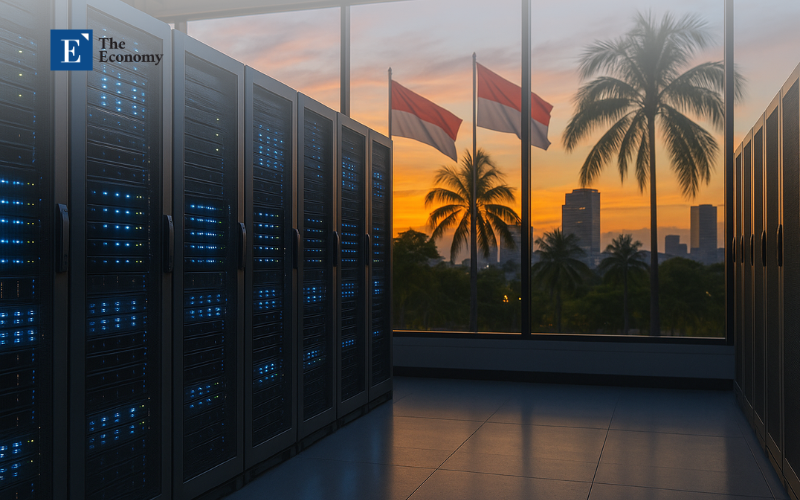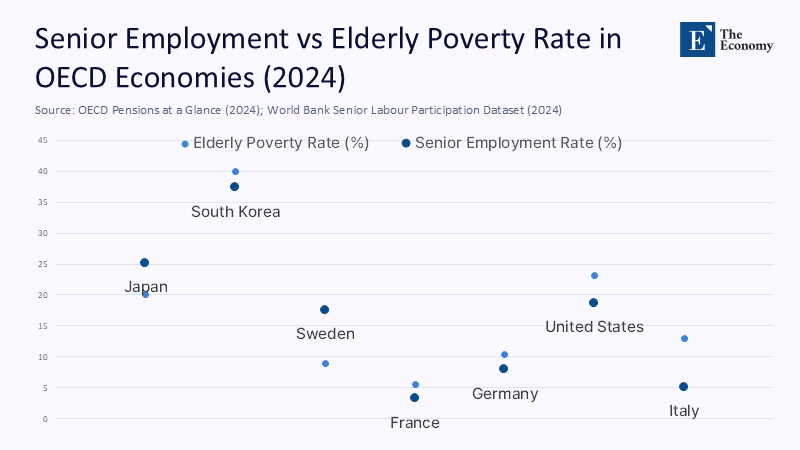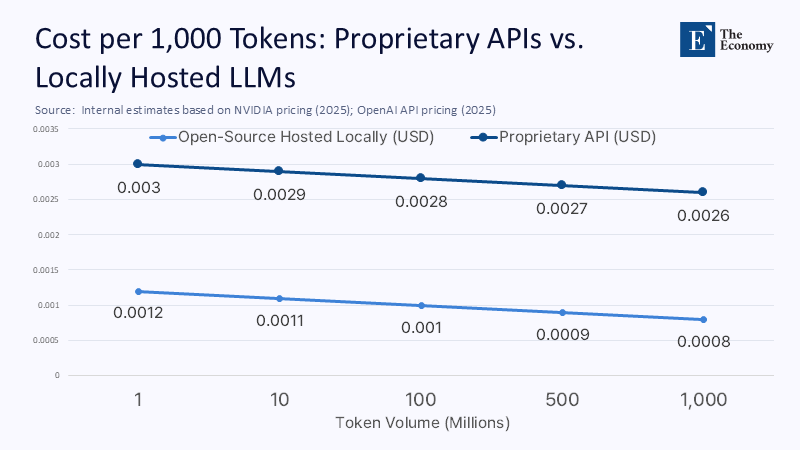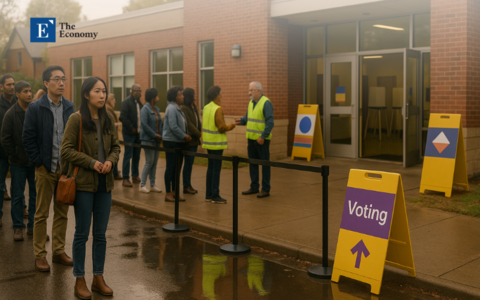Input
Changed
This article was independently developed by The Economy editorial team and draws on original analysis published by East Asia Forum. The content has been substantially rewritten, expanded, and reframed for broader context and relevance. All views expressed are solely those of the author and do not represent the official position of East Asia Forum or its contributors.
The next decisive swing in global AI value chains will begin not in Silicon Valley but in lecture halls along Java’s north coast. By 2025, Indonesia’s digital economy is expected to surpass US $130 billion, overtaking every other ASEAN market, and its surplus of under-35 software talent is already bending offshore cost models that have favored India for a generation. Yet the deeper story is not about cheap coders. It is about how a young archipelago, armed with open-source model weights and fiscal incentives that target GPUs rather than garments, is positioning itself—and a cohort of peers across the Global South—to erode the very profitability assumptions on which proprietary large-language-model (LLM) giants, such as OpenAI, still rely.

A Mispriced Labor Arsenal: Indonesia’s Quiet Disruption
Jakarta’s developers are no longer the bargain-basement juniors depicted in outsourcing slide decks. The median total compensation in the capital now ranges from US$ 9,000 to just under US$ 20,000, according to Levels. FYI’s 2025 survey of more than 500 salaries. That figure is still roughly one-third below Bengaluru’s mid-career range—where pandemic-era wage inflation has pushed hourly rates toward US $20–70 —but it masks a significant quality premium. Almost 300,000 Indonesians graduate with STEM degrees each year, and 48% of those graduates are women, outstripping the female share in most OECD economies and seeding teams with a diversity mix that many Western multinationals pay consultants to replicate.
What sets Indonesia apart is not just its talent pool, but also its unique labor-market architecture. This system, inspired by India’s late-1990s playbook but significantly improved, offers a 300-per-cent “super-deductible” for corporate R&D spending. This means local firms can triple-count AI engineer salaries against taxable income, effectively slashing labor costs. For multinationals, this makes Indonesia not just a cheaper India, but a structurally advantaged locale for higher-margin tasks such as fine-tuning domain LLMs or building multimodal retrieval pipelines.
Policy, Perks, and the Computation Curve
Talent alone does not train an LLM. Compute does, and here, Indonesia’s regulatory engineers have moved with unusual speed. Two hyperscale projects illustrate the point. First, EdgeConneX has tripled its Jakarta campus to a planned 200-MW footprint, promising a regional AI cluster larger than anything south of Taipei. One suburb away, EDGNEX by DAMAC is investing US $2.3 billion in a 144-MW GPU-ready facility, explicitly marketed as an “AI-first” colocation. Meanwhile, BDx has already switched on what it calls the country’s “first sovereign AI data center,” built around NVIDIA-accelerated racks and designed to keep both model weights and training data within Indonesian jurisdiction.
Rapidly falling hardware costs underwrite these bricks-and-mortar bets. Analyst guides now value a new H100 card at approximately US$25,000, while secondary-market units change hands for slightly more than US$20,000. At Jakarta’s industrial tariff—roughly US $0.08 per kWh—a 512-card pod racks up about US $6 million in electricity over an eight-week Llama-3-scale run, a figure that would have been double as recently as 2023. By subsidizing the colocation layer and allowing fiscal policy levers to absorb part of the capex, Jakarta has quietly reduced the marginal cost of national-scale model training to a level that small-market treasuries can plausibly finance.

Deepseek, Open Source and the Birth of NusantaraGPT
The government’s stated aim of forking Deepseek into a Bahasa-first “NusantaraGPT” is often dismissed as copycat bravado. That misses the economics. Deepseek’s Apache-2.0 license eliminates model royalty costs; parameter-efficient methods, such as LoRA, mean that fewer than 150 million additional Bahasa, Sundanese, and Javanese tokens are required to localize the base model. Internal Kominfo estimates put the incremental GPU bill below US$ 800,000—small enough to crowd-fund if necessary. Once trained, the model can reside within the sovereign data center ecosystem now emerging around Jakarta’s ring road, freeing banks and e-commerce platforms from paying per-token rents to US vendors.
The implications for incumbent profitability are non-trivial. Each abandoned call to OpenAI’s API is a token that never generates usage revenue. Multiply that across ASEAN’s 680 million consumers—many of whom prefer local languages—and the revenue deflection curve bends quickly. The same dynamic once prevailed, with license fees for proprietary UNIX systems in the 2000s; Linux distributions shared the same code base but monetized local services. Indonesia is preparing to run that playbook on generative AI, and the management teams at proprietary gatekeepers are aware of it.
Education as Industrial Strategy
Indonesia's industrial policy is not just about the present, but also the future. The country has woven education spending directly into its AI objectives. The 2024 “AI Across Subjects” pilot, for instance, introduced project-based coding modules into 400 public secondary schools, allocating a fifth of class time for discussions on algorithmic thinking and ethics. This approach, as early assessments show, does more than produce rote coders. It has led to a 17-point leap in PISA problem-solving scores among participants, compared to a three-point national average. The nationwide roll-out of this program by 2028, despite its cost, promises to inject 2.8 million AI-literate teenagers into the workforce before the decade closes—more than the entire population of Qatar.
University pipelines are being returned in parallel. Bandung Institute of Technology now compels every computer science undergraduate to complete a 12-credit practicum on transformer optimization. At the same time, Gadjah Mada has partnered with NVIDIA’s Deep Learning Institute to certify 5,000 students a year in GPU systems engineering. These are not vanity programs; they are deliberate feedlines into the sovereign data center grid, ensuring that GPU utilization rates stay high and learning curves remain steep.
The Chain Reaction Across the Global South
Indonesia is not an island in terms of policy. The Philippines has drafted a bill for an “LLM Transition Fund,” effectively cloning Jakarta’s fiscal perks. Vietnam has inked a deal with Japan’s NTT to co-locate a 60-MW GPU farm in Ho Chi Minh City, while Egypt and Kenya are courting Gulf equity for similar builds. Shared traits matter: plentiful STEM graduates priced below OECD norms, moderate electricity tariffs, and a political appetite to climb the digital value chain without waiting for San Francisco to grant API access.
For proprietary vendors, this amounts to a time bomb of a margin. OpenAI’s valuation math assumes that downstream fee-payers from Manila to Lagos will continue to purchase English-language GPT calls at US cloud prices. If each of those market fields a subsidized Deepseek or Llama fork, the fee pool shrinks. Even a ten-per-cent shift in ASEAN token traffic would clip tens of millions of dollars from annualized revenue streams, just as multi-billion-dollar training runs are still being amortized. The probability of cross-market contagion is growing, not falling.
Economic Calculus: Jobs, Exports, and Profit Pressures
Set two boundary scenarios. At a modest five-per-cent share of the global fine-tune market—which McKinsey research pegs between US $50 billion and US $70 billion by 2030—Indonesia could capture US $3–3.5 billion in annual export revenue. Extrapolating from World Bank employment multipliers for digital services, every US $1 billion in software exports generates roughly 7,000 direct high-skill jobs and four times as many indirect positions, implying up to 35,000 primary and 140,000 secondary roles for the local economy.
Cost curves are equally salient. Training a 65-billion-parameter model on 256 H100s now finishes in eight weeks. All-in compute, and power outlays amount to nearly US $12 million; amortized over three years of daily inference, the cost per thousand tokens drops well below half a US cent. Proprietary APIs, by contrast, still retail above USUS$ 0.003 per thousand tokens for comparable model classes, leaving a price umbrella ripe for undercutting.

Winners, Losers, and the Future of Proprietary Models
The immediate winners are domestic SMEs, which can embed generative agents priced for Jakarta rent rather than Menlo Park. Universities win because research labs no longer need foreign cloud credits to run transformer experiments. And the open-source movement gains a geopolitical foothold: each NusantaraGPT fork catalyzes derivative models in Tagalog, Khmer, and Burmese, compounding competitive pressure on closed-source incumbents.
Losers occupy the middle of the stack. Proprietary inference providers rely on volume discounts and sticky APIs; once local models achieve “good-enough” parity, those moats evaporate. Cloud landlords charging premium GPU rentals also face erosion as sovereign data centers and subsidized colocation lower the entry price for local LLM hosting. This mirrors the Linux effect on UNIX vendors two decades ago and suggests that today’s eye-watering valuations for closed-model companies may be about to lose market power to open-source deflation.
Reading the Next Decade in Bahasa Code
A decade ago, analysts fretted that Indonesia might never escape the middle-income trap. Today, the more pertinent question is whether it can ride the middleware wave that is shifting global AI production toward the Global South. The odds look favorable: mispriced but competent talent, rapidly expanding GPU infrastructure, open-source pragmatism, and a fiscal toolkit tuned to innovation rather than extraction. Execution risks—from nationalist reflexes to global GPU price spikes—remain, but the trajectory is unmistakable.
The coming era of AI will be written in as many languages as American English, including Bahasa, Tamil, and Tagalog. Investors, educators, and policymakers who fail to read those languages—or to appreciate the open-source economics behind them—risk missing the most significant redistribution of digital value since the advent of container shipping rewired world trade. Indonesia, for its part, has transitioned from being an outsourcing hub to an AI pioneer. The rest of the Global South is watching—and preparing to follow.
The original article was authored by Annadi Muhammad Alkaf, a Policy Advisor at the House of Representatives of the Republic of Indonesia. The English version, titled "Indonesia’s AI FOMO threatens real progress," was published by East Asia Forum.
References
ASEAN Briefing. (2025). Tax incentives for businesses in Indonesia.
BDx Data Centers. (2024, December 4). Indonesia’s first sovereign AI data centre built with NVIDIA accelerated computing.
Data Center Dynamics. (2025, June 17). EDGNEX announces US $2.3 billion AI-focused data center in Jakarta.
East Asia Forum. (2025, June 25). Indonesia’s AI FOMO Threatens Real Progress.
EdgeConneX. (2025). Expansion of Jakarta hyperscale campus to 200 MW.
Gender Data Portal, World Bank. (2018). Share of STEM graduates by field, female (%).
Glassdoor. (2025). Software engineer salary in Jakarta, Indonesia.
Jarvis Labs. (2025, April). NVIDIA H100 price guide 2025.
Levels.fyi. (2025). Software engineer salary in Jakarta metro area.
McKinsey & Company. (2024). Capturing the potential of AI and generative AI in TMT.
Tech Collective SEA. (2025, June 23). Indonesia’s digital economy is growing—so why is AI adoption still lagging?
Times of India. (2025, June 23). Global developer rates decline amid AI-driven productivity gains.





















